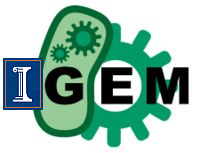Team:Illinois/Project
From 2008.igem.org
m (→Overall project) |
|||
| Line 137: | Line 137: | ||
{|align="justify" | {|align="justify" | ||
|We are the inaugural iGEM team here at the University of Illinois. We are very excited to be participating and look forward to a summer full of fun, learning, and hopefully a successful project. | |We are the inaugural iGEM team here at the University of Illinois. We are very excited to be participating and look forward to a summer full of fun, learning, and hopefully a successful project. | ||
| + | |||
| + | |||
| + | The unifying motivation behind our research this year is the creation of novel diagnostic tools for medicine. To this end, we are conducting three parallel research projects to create cell-based biosensors. We are currently engineering a bimolecular fluorescence system in which two halves of a fluorescent protein, each fused to an antigenic epitope, will bind to the two sites on an antibody in human serum to cause a detectable fluorescent signal when antibodies against this specific antigen are present. These proteins can be produced in bulk through a bacterial expression system. We are also pursuing similar diagnostic objectives using a eukaryotic system; we are designing strains of yeast able to respond specifically to immunogenic epitopes or antibodies, and activate a fluorometric or enzymatic response accordingly. We are fusing antibodies against immunological targets to cell surface receptors of transcriptional signaling pathways, which would become activated only in the presence of these pathogens. | ||
| + | |||
|[[Image:Example.png|200px|right]] | |[[Image:Example.png|200px|right]] | ||
|} | |} | ||
Revision as of 01:51, 29 September 2008
| Home | Team | Notebook | Research Articles | Protocols | Project | Pictures | Parts |
| We are the inaugural iGEM team here at the University of Illinois. We are very excited to be participating and look forward to a summer full of fun, learning, and hopefully a successful project.
|
Contents |
Overall project
For our project we intend to create a yeast-based biosensor capable of detecting and signaling the presence of a pathogen. We intend to use directed evolution to develop a cell surface receptor capable of binding the pathogen. This receptor will then initiate a signaling cascade which will induce a change in the yeast, a color change for example. This project is important because there is a demonstrated need for cheap and effective monitoring of water-borne pathogens in the third world where traditional detection methods are not feasible.
Subprojects
To improve our odds of achieving our project we have decided to modulate our team into 3 disparate groups, each pursuing variant methods to accomplish the above goal, that is, cheap detection of water-bourne pathogens. The three methods and teams are detailed below.
If you were not present at the June 10th meeting, pick a group and contact the members.
Antibody GPCR Fusion
This team will attempt pathogen detection by fusing the appropriate antibody domain to a GPCR receptor and upon binding of the target protein (i.e. cholera toxin), linking the resulting signal cascade to transcription of a reporter, GFP or LacZ.
Antibody Receptor Tyrosine Kinase Fusion
This project will attempt to detect a pathogen by using a secreted antibody or antibody fusion protein.
Bimolecular Fluorescence Biosensor
A soluble biosensor that activates a fluorescent protein upon binding a specific biomolecule
Results
| Home | Team | Notebook | Research Articles | Protocols | Project | Pictures | Parts |
 "
"
